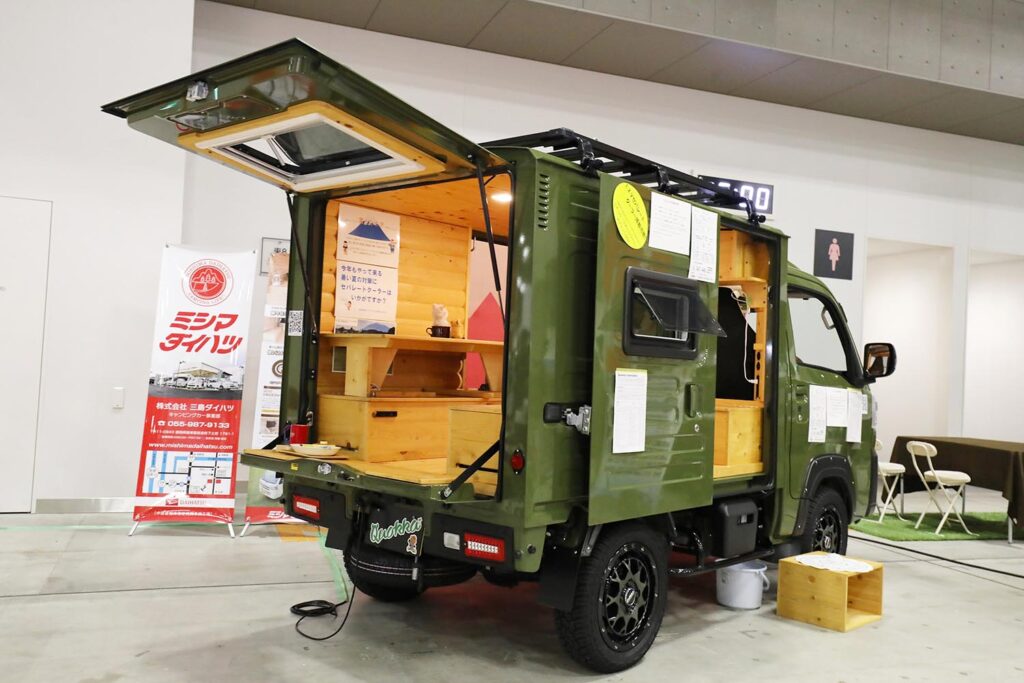Using cypress grown in the great nature of Fuji
Mishima Daihatsu proposes a camper that uses Fuji cypress from Shizuoka Prefecture and offers the warmth of solid wood. The kei-camper, given the catchphrase “Traveling Little Log House” and the name “Quokka Wannabee”, will surely be a messenger of happiness to its owner.
Cypress is the perfect material for camper interiors
Have you ever heard of the ‘quokka’ (quokka wallaby)? This small animal lives on Rottnest Island, a harbor town near Perth, Australia, and is characterized by its unguarded and very friendly nature. They are popular for their lovely faces, which always seem to be smiling because of the raised corners of their mouths. According to one theory, it is also said to have been the model for Pikachu, the well-known character from Pokémon.
In honor of such a cute and lovable quokka, Mishima Daihatsu named its original camper “Quokka Wannabe”. The base vehicle is a Daihatsu Hijet Panel Van. Quokka, a resident of the Australian forest, fits perfectly with the image of the camper model, which is made from plenty of Japanese cypress grown in the wilds of Fuji.
The Fuji cypress used grows slowly and strongly in volcanic ash soil and is regarded as the best wood for its strength, durability, moisture retention, and humidity control. In addition, the scent of the cypress has a calming effect that relaxes people, and it also contains ingredients that are recognized to have a disinfectant effect. This makes it an ideal material for campervan interiors.
As for the equipment of a campervan, firstly, it has a seating capacity of two passengers and a sleeping capacity of two. The front of the cargo area is covered with Fuji cypress interior material, creating a space with the warmth of wood. In addition, the space is designed to improve thermal insulation and humidity control.
The interior of the car is tailored like a mountain cabin or lodge
The interior also shows the attention to timber, with the cabin tailored to look like a mountain lodge or lodge, making it a very comfortable and relaxing space. It’s so cozy that you forget the passage of time.
The interior consists of six transformation palettes-large, medium, and small can be combined to create storage units, tables, and even a full-flat bed that can be laid out as a floor. The unfolded bed dimensions are 1850 mm long x 860 mm wide and can sleep two adults.
As for this transformation pallet, it also has a convenient feature that allows it to be used outdoors as a chair. It is washable even if it gets dirty, so it can also be used as a step stool, scaffold, or storage, expanding the possibilities for outdoor use.
Both local production for local consumption and the wishes of the representative
The representative of Mishima Daihatsu, Mr Uchimura, himself a long-time campervan user, has always had the desire to build a campervan that can be freely rearranged. The wood used was the local Shizuoka Fuji cypress, and after a process of trial and error, the result was a camper that could be arranged comfortably and conveniently in a limited space. The result is the “Quokka WANABY”, which combines local production for local consumption with the wishes of the representative of the company.
Of course, the basic equipment of a camper is also substantial: electrical systems such as DC and USB outlets are standard. In addition, optional equipment such as solar panels, a 200 Ah lithium-ion battery, a driving charge enhancement system, a refrigerator, and a microwave oven can be selected.
The Quokka Wanabee has a luxurious and comfortable interior made from Fuji cypress. As a running log house, it was one of those vehicles that made you want to go on a free-spirited journey.
translated by DeepL
